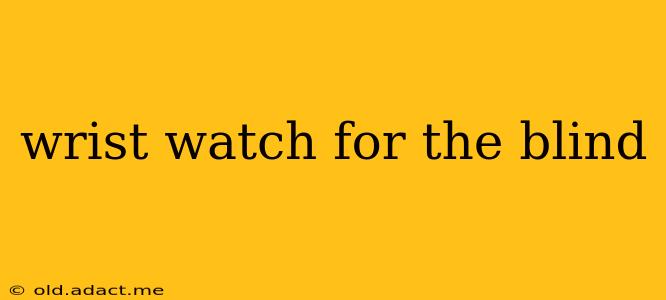Finding the right wristwatch can be challenging for anyone, but for visually impaired individuals, the search requires a deeper understanding of available technologies and features. This guide explores the diverse world of accessible timepieces, addressing common questions and concerns. We'll delve into the different types of watches available, the technologies they employ, and considerations to make when selecting a watch for someone with visual impairments.
What are the best wrist watches for the blind?
There's no single "best" wristwatch for the blind, as the ideal choice depends heavily on individual needs and preferences. However, several types excel in providing accessible time-telling solutions:
-
Talking Watches: These watches verbally announce the time, often including the date and day of the week. They are arguably the most common and user-friendly option for blind individuals. Different models offer varying levels of detail and voice customization.
-
Braille Watches: These watches feature raised Braille numerals on the watch face, allowing users to read the time through touch. The clarity and size of the Braille characters are key factors to consider.
-
Combination Watches: Some watches combine tactile Braille displays with audible announcements, offering a versatile solution for diverse users.
-
Simple Analog Watches: While seemingly basic, a well-designed analog watch with large, raised hour markers can be surprisingly effective for someone with some residual vision. A clear, bold design is crucial here.
What features should I look for in a watch for a blind person?
Beyond the basic time-telling mechanism, several features significantly enhance usability for visually impaired individuals:
-
Clear and Loud Audio: For talking watches, audio clarity and volume are paramount. Look for watches with adjustable volume and a voice that’s easy to understand.
-
Intuitive Controls: The watch should be easy to operate, even with limited or no vision. Large, well-defined buttons are essential.
-
Durable Construction: A watch designed for daily use needs to withstand wear and tear. Consider materials and construction that ensure longevity.
-
Battery Life: Long battery life is crucial to minimize the inconvenience of frequent battery changes.
-
Water Resistance: For active individuals, water resistance is an important safety feature.
How much do watches for the blind cost?
The cost of watches designed for the visually impaired varies considerably depending on features, brand, and technology. Prices can range from relatively affordable to quite expensive, reflecting the sophistication of the technology involved.
Are there smartwatches for the blind?
While not as common as specialized talking or Braille watches, some smartwatches offer accessibility features that can benefit blind users. These features might include screen reader integration, voice control, and haptic feedback. However, navigating the complex interfaces of smartwatches can sometimes present challenges.
Where can I buy a wrist watch for the blind?
Watches for the visually impaired can be purchased from various retailers, including online stores specializing in assistive technology and some general watch retailers. It's always advisable to read reviews and compare different models before making a purchase.
What are the differences between talking watches and Braille watches?
Talking watches provide auditory feedback, announcing the time verbally, while Braille watches rely on tactile feedback through raised Braille numerals. The choice depends on individual preferences and the user's ability to read Braille.
Can a blind person use a regular watch?
Depending on the level of vision impairment and the watch design, a regular watch might be usable. A large, simple analog watch with clear, raised markers may be sufficient for some individuals with some residual sight. However, for those with complete vision loss, a talking or Braille watch is typically necessary.
This guide offers a starting point for understanding the diverse range of wristwatches designed to meet the needs of visually impaired individuals. Remember to prioritize features that best suit the user’s specific requirements and preferences. The right watch can significantly improve independence and quality of life.
